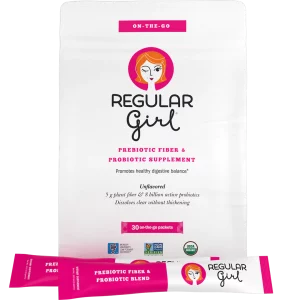By Erin Judge, RDN

Dietary fiber can only be found in plants. There are two forms: insoluble and soluble. We don’t digest insoluble fiber. It forms a soft pulp as it moves through the colon, carrying toxins with it as it leaves the body and provides the roughage for poop formation. Soluble fiber dissolves in water and influences how your gut contents move stool through your digestive tract. It can also help you feel less hungry.
Beneficial gut microbes (learn more about these guys here!) rely on fiber to perform their roles in the body effectively. These include help with digestion, metabolism, hormone balance, mood and more! As microbes feed on soluble fiber through a process referred to as “fermentation,” they produce short-chain fatty acids and gas.
It’s important to talk with your doctor about the gas you are experiencing so you can rule out conditions such as poor carbohydrate digestion; intolerance of lactose, sucrose or fructose; and poor movement of stool through the digestive tract, all of which may also create more gas. Gas can also be caused by swallowing excess air.
When it comes to food intake, especially fiber intake, there are a few reasons you may be experiencing more gas:
- Increasing fiber too quickly. Since gut microbes are breaking down fibers, too much too quickly can be a lot to handle and may lead to an increase in gas as your microbes adjust to the quantity.
- Poor diversity or quantity of gut microbes. If the makeup of your gut microbes isn’t ideal, fiber may not get broken down as smoothly and this could lead to excess gas production.
- Eating raw fibers. Fiber-rich foods are more difficult to break down than fiber-poor foods. Cooking helps break them down for easier digestion. Raw fibers are typically going to lead to more gas and discomfort, especially if the increase of fiber is new.
- Choosing highly fermentable (AKA gas-causing) fibers. Not all fibers are created equal. Some, such as inulin, may cause more gas production than others so if you’re loading up on these, you may have more gas.
- Poor hydration. More fiber intake also requires more water intake. Poor hydration and high-fiber diets can lead to more gas and discomfort.
- Constipation. If you’re not having regular bowel movements, you may be experiencing more gas.
How to increase your fiber without also increasing the gas:
- Start small and increase slowly. Instead of adding in huge amounts of fiber all at once, try adding a portion of a fiber-rich food (think: PLANTS!) every few days until you get to the amount you want.
- Spread out your fiber throughout the day. Instead of packing all of your fiber in one meal, try to spread out fiber sources in all meals and snacks. This will decrease the amount of gas produced at once and lead to better tolerance.
- Prioritize prebiotic fibers and researched probiotics for more beneficial gut microbes. Prebiotics are like the fiber A-players because they are shown to have a benefit for their host (you!). Regular Girl contains a prebiotic and probiotic in one to make this easy! The prebiotic soluble fiber found in Regular Girl is well-tolerated. It blends easily and invisibly into water as well as your morning smoothie.
- Cook the majority of your fiber-rich foods and choose less fermentable fiber options. Highly fermentable fibers include those that are cruciferous, as well as FODMAPs (more on those here). When starting out, cook your fibers and be mindful to limit your cruciferous vegetable intake. These include cabbage, broccoli, cauliflower, kale, and brussels sprouts. Get creative by mixing in variety with other fiber sources.
- Hydrate. Be sure to stay hydrated by drinking plenty of water and fluids each day.
- Promote healthy, regular bowel movements to prevent constipation. Hydration, fiber intake, movement, exercise and adequate sleep can all help with this.
If you notice that the gas is still not improving after trying these tips, or you’re feeling stuck increasing your fiber, talk with your doctor and work with a registered dietitian nutritionist to personalize your plan so you can optimize your diet, without the discomfort.







0 Comments